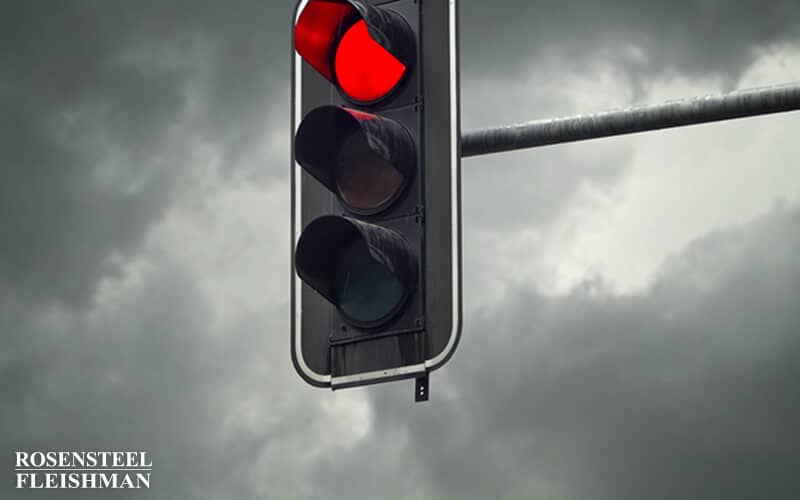Being in a car accident is stressful enough, but the situation can become even more complicated if the other driver doesn’t have insurance. It’s one of those moments where confusion and frustration collide, especially when you’re stuck with damage to your vehicle or even injuries. Many people in Charlotte find themselves in this exact situation, […]

Duty to Anticipate Driver Running Red Light… Sometimes
The North Carolina Supreme Court recently affirmed an appeal from the court of appeals in a case which involves a common traffic scenario. Car #1 approaches wants to turn left at an intersection with a traffic signal but no left turn signal. It enters the intersection and comes to a complete stop waiting for a break in traffic coming from the other direction. That break does not come until the light turns red, so Car #1 does not complete his left turn until after the light turns red. Most of the time, this common traffic scenario occurs with no problems. In Ward v. Carmona (N.C. 2015), however, Car #2 was coming from the opposite direction, entered the intersection after the light had turned red, and collided with Car #1 while it was completing its left turn. The Court held that the drivers of both cars were negligent and the owner of Car #1 was correctly denied damages from the driver of Car #2 because of the contributory negligence of the driver of Car #1.
In its analysis, the court noted that a plaintiff who wishes to prove negligence must show
First that there has been a failure to exercise proper care in the performance of some legal duty which the defendant owed the plaintiff . . . and, second that such negligent breach of duty was the proximate cause of the injury—a cause that produced the result in continuous sequence and without which it would not have occurred, and one from which any man of ordinary prudence could have foreseen that such a result was probable under all the facts as they existed.
The court of appeals reasoned in its analysis of Ward that
Drivers approaching an intersection have a duty to maintain a lookout and to exercise reasonable care under the circumstances. Hyder v. Asheville Storage Battery Co., 242 N.C. 553, 557, 89 S.E.2d 124, 128 (1955). Failure to do so “is likely to endanger the safety of persons and property.” N.C. Gen. Stat. § 20-4.23(a)(2) (2011). When drivers approach a green traffic signal at an intersection they must keep “a reasonable lookout for vehicles in or approaching the intersection at excessive speed.” Hyder, 242 N.C. at 557, 89 S.E.2d at 128. They have a duty to “anticipate and expect the presence of others.” Id. Drivers “cannot go forward blindly even in reliance on traffic signals.” Id. Furthermore, “[a]ny person who undertakes to drive a motor vehicle upon a highway must exercise reasonable care to ascertain that such movement can be made in safety before he turns to the right or left from a direct line.” Wiggins v. Ponder, 259 N.C. 277, 279, 130 S.E.2d 402, 404 (1963) (emphasis added); see also N.C. Gen. Stat. § 20-154(a) (2011).
The North Carolina Supreme Court cautioned that the reasoning from the court of appeals should not be read to contradict North Carolina G.S. 20-158(b)(2)(a), which states that “[w]hen a traffic signal is emitting a steady red circular light controlling traffic approaching an intersection, an approaching vehicle facing the red light shall come to a stop and shall not enter the intersection.”
Looking at the situation of the driver who seeks to make a left turn at an intersection with a traffic signal, the Court stated that
If [the driver] entered the intersection while the circular light was green and the light turned red, he was permitted to complete his turn to exit the intersection and avoid blocking traffic as long as he maintained a lookout and exercised reasonable care under the circumstances. If [the driver] had not yet entered the intersection when the light turned red, he had a duty to stop.
The Court then looked at previous North Carolina Supreme Court case which involved the situation of a plaintiff who was hit while proceeding through a green light by a defendant who ran a red light. In Cicogna v. Holder (1997), the Court stated that the plaintiff was only contributorily negligent if he was put “on notice that the defendant would not obey the traffic light.” Absent such notice, “[t]he plaintiff was not required to anticipate that the defendant would be negligent.”
The North Carolina Supreme Court distinguished Cicogna from Ward as follows:
The undisputed evidence presented in Cicogna showed that the plaintiff had a green traffic light and proceeded straight into the intersection as allowed under North Carolina law. The defendant approached from the plaintiff’s left. These important distinctions show Cicogna is not controlling.
Although the Court does not explain further, we can further describe the difference in the two situation. In Cicogna, because the driver of Car #1 was proceeding straight through the intersection and had a green light, he was most likely looking in front of him and not looking left and right for cars approaching from these directions. In Ward, however, the driver of Car #1 was fully stopped at the intersection waiting to turn left. He was waiting for a break in oncoming traffic to do so, but this break did not come until the light turned red. Because he was watching oncoming traffic, he should have been on notice of any oncoming cars which might have entered the intersection through a red light. Therefore, consistent with Cicogna, the driver of Car #1 should have been “on notice that the defendant would not obey the traffic light” and therefore could be held contributorily negligent.
If you have been injured in a car accident, contact an attorney at Rosensteel Fleishman Car Accident & Injury Lawyers (704) 714-1450, to discuss your options.
Additional Car Accident Articles
Getting into a car accident can throw everything into chaos in a matter of seconds. Whether it’s a fender-bender or something more serious, the moments afterward are often filled with questions, stress, and uncertainty. You might be wondering what your next move should be, especially if the damage is more than just physical. If you're […]
Getting into a car accident can throw everything off balance. One moment you're running errands or heading home from work, and the next you're dealing with a damaged vehicle, lingering soreness, and a pile of unanswered questions. It's easy to feel overwhelmed, especially when you're unsure what to do next or who you can turn […]
Neck injuries after a car accident can be confusing, frustrating, and even scary—especially when the pain doesn't show up right away. For many people, the moments after a crash are filled with adrenaline, and it’s easy to overlook subtle signs of injury. But what happens when the pain starts hours or even days later? It's […]
